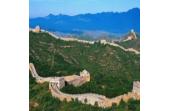Guyuan
- Things to do
-
- Photo(42)
- Tips&article(12)
- Make it Happen
- Map
-
loading...
Top 5 Lists
The city of Guyuan is located in the southern part of the Ningxia Hui Autonomous Region. It is about 340 kilometers (about 211 miles) away from Yinchuan, the capital city of the region. Car travel from Yinchuan takes about 4 hours, and bus travel takes about 4 to 6 hours, depending on the number of stops.
Its eastern, western and southern boundaries border on Gansu province, and its northern part touches Zhongwei and Tongxin, two counties in the area. It has a total area of 16,783 square kilometers that includes one administrated area called Yuanzhou and several counties including: Xiji, Longde, Jingyuan and Pengyang.
It has a population of 1.9 million. Hui people are about 49% of the population. It is one of the biggest Hui communities in China.
Guyuan is a historic city. The Great Wall section built by the Qin dynasty passes about 10 kilometers away from the city. Later, Guyuan was a garrison station of Gaoping and Anding counties founded by Emperor Wu of the Han dynasty. It used to be a relatively large city judged by remains such as pottery pipe that was used for sewers in cities during the Han dynasty.
There are two ideas about how the name originated. One version is that the city was once called the "old Yuanzhou." The word old in Chinese is "gu," and so putting gu and Yuan together, people called the city Guyuan. The other idea of its origin is that since the city has a dangerous position that was difficult to travel to, it was named Guyuan.
The city was founded about 524 and has had about 1500 years of history. In 1575, the city was enlarged so that there was an inner area surrounded by the city wall, and an outlying area. The city once looked magnificent. During and after the Qing Dynasty (1644-1911 AD) however, the city was destroyed by wars and earthquakes.
The city of Guyuan has beautiful scenery and interesting historical sites. Enjoy the landscape, the Great Wall of the Qin Dynasty, the remains of the ancient city that was built in the Han Dynasty, and the grotto on Xumi Mountain that was built during the Northern Wei era that was a summer residence of Kublai Khan, the Mongolian first emperor of the Yuan dynasty. You'll find the remains of a great civilization. The Liupan Mountain natural reserve that have Laolong Pond, the Liangdian Gorge and the Lotus Garden is the area's natural scenic highlight.
Tips
Telephone Area code: 0954
Postal code:756000
Tips & articles
|
|
|
forum discussion
|
|
|










